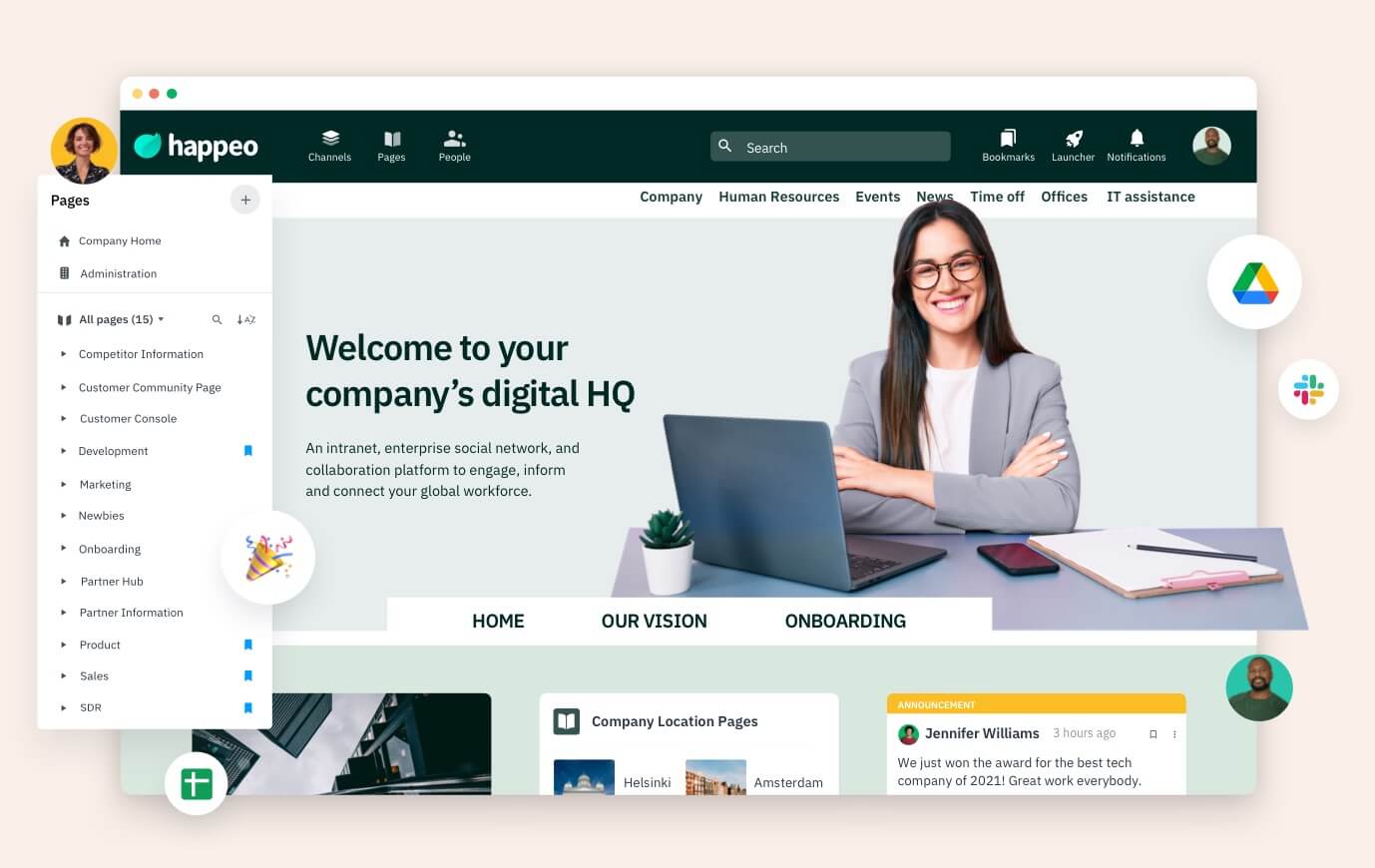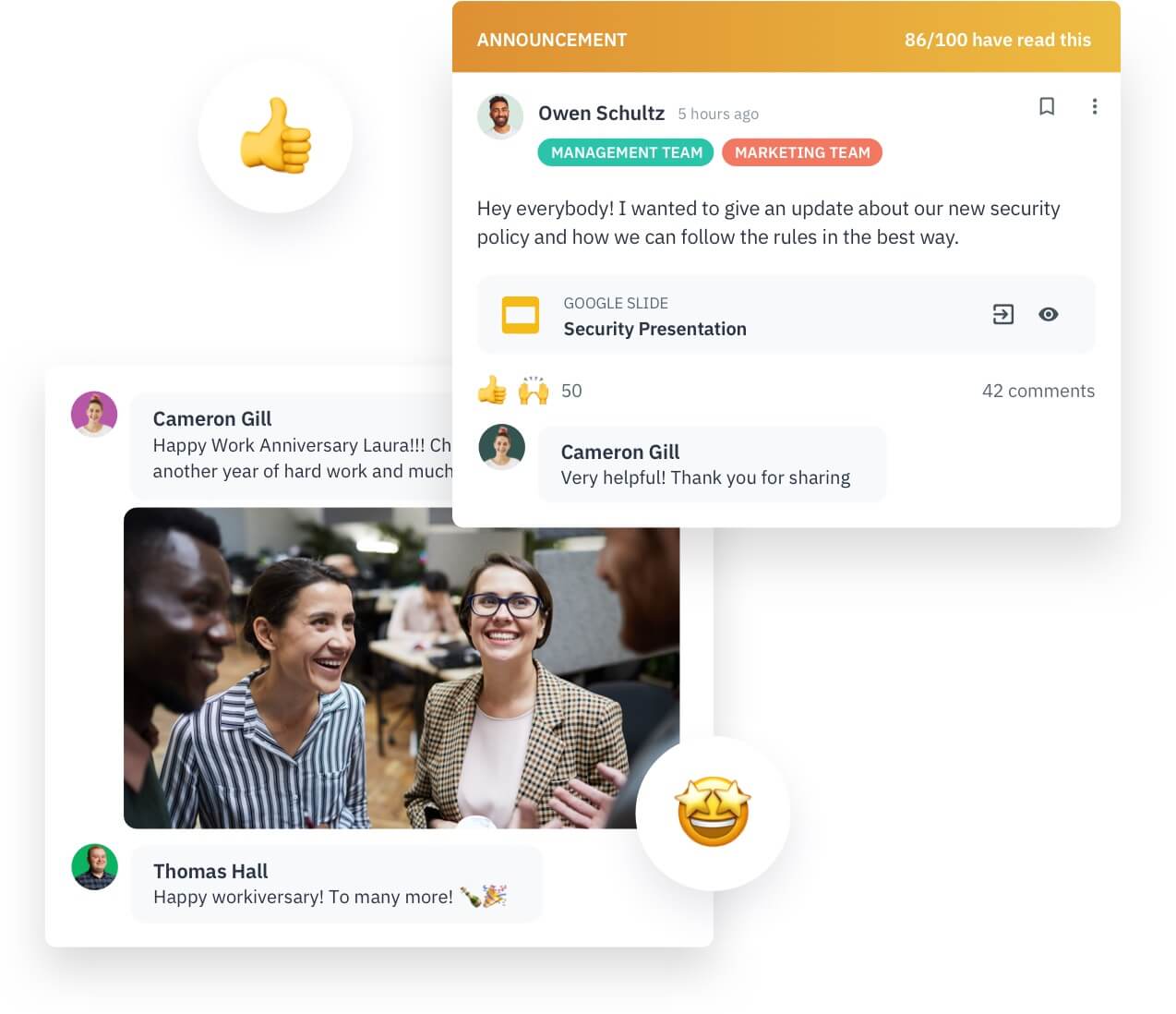Intranet definition
Keep reading to find out:

Take the first step toward your AI‑powered intranet
Watch Happeo demo →
What is an intranet?
An intranet can be defined as a private network used by an organization. Its primary purpose is to help employees securely communicate with each other, to store information, and to help collaborate. Modern intranets use social intranet features that allow employees to create profiles and to submit, like, comment, and share posts.
What are the uses of an intranet?
An intranet software is primarily used by organizations as a tool to:
- Share organizational updates
- Store files
- Connect employees
- Collaborate with teams across borders
- Increase productivity
- Give employees a voice in the organization
Improve productivity and employee engagement
When intranets first became heavily utilized, its purpose was mainly for top-down communication and file storage. Negative opinions on the effectiveness of an intranet are usually associated with top-down communication. These days, the intranet is made to allow both bottom-up and top-down communication. Top-down is necessary to get employees aligned with the organization's vision and mission, where bottom-up communication is unmissable for real employee engagement. The best intranet embraces and allows management and the employees to communicate in an organic fashion. Ultimately, the use of intranets improve productivity.
Discover all the features of an intranet software
Download now
What are the benefits of an intranet?
Whether cloud-based or on-premise intranet, using an intranet has many benefits. Some of the biggest benefits are
- Access to organizational data and files anytime, anywhere
- Increases internal communication
- Connects employees
- Increases employee productivity
- Drives employee engagement
- Enhances collaboration
- Integrates with third-party tools
- Stores securely document
- Boosts employee recognition and rewards
- Encourages knowledge sharing
Improve communication with an intranet
Agility is the new century’s buzzword for business success. Adapting fast means acting fast, acting fast means communicating fast. An intranet brings your organization together, no matter where they are. It allows everyone to communicate what’s necessary for greatness – from the CEO to the janitor. Add integrations with your most-used business apps, quick adoption, a user-friendly interface and security, and you have a winning intranet platform for a more agile business. All you need is a web-browser and internet access.
Want to know more about cloud-based intranets? Read about Google intranet solutions and how they can benefit your organization.
What should an intranet include?
A successful intranet includes some essential features that make it a valuable channel for communication and collaboration. Some of the features are:

Share files
Your intranet platform will either integrate with existing file-sharing solutions (e.g. Google Workspace apps like Google Drive, Dropbox, OneDrive or others), or have its own file-storing system.
Collaboration
Modern intranets allow you to directly work on documents, spreadsheets, slides or other frequently-used apps in your productivity suite. Rather than just linking to a file stored in the cloud, editing it directly makes conversation and collaboration revolve around what really matters – work.
Enterprise search
Because you store a lot of information on your intranet, search is one of the most frequently-used features in an intranet. The best intranets offer enterprise search and search across information in pages or posts, but also in file names.
Mobile access
Most modern intranets offer a mobile intranet app, so you can stay connected on the go. Since work is increasingly less dependent on your device, a mobile app simply means that employees can stay engaged, wherever they are.
Find people
When you have a large organization, finding the one person you need can be a challenge. Almost all intranet platforms have a employee directory – the most useful ones are auto-generated. Here you can search for people across location, job title or even skill set, depending on your intranet solution.
Build pages
A page builder tool is essential for static communication, but it can do much more than just inform. Automate your onboarding journey, house your brand assets, make wiki pages or set up a place to request IT assistance.
Employee engagement
At the end, this is what you will truly want to accomplish with your intranet solution. Gluing a global workforce together is no easy feat, and keeping them engaged is key. A once-a-year survey just won’t cut it – you need a scalable solution to let employees voice concerns, and to listen.
Analytics feature
That’s the great thing about an intranet – with strong analytics features you will be able to measure and gauge the sentiment around your organization, a specific post or an internal campaign. In other words: it truly measures employee engagement.
Personalized timelines
Eliminate distractions and see the news that matter most. You can choose to personalize your timeline only with the Channels you follow.
Automatic archiving
Make sure that stale content will be archived automatically or reviewed by owners. This helps to keep the information up to date, or at least get rid of the unnecessary information that no one has actively used or updated.
Custom branding options
Tailor your domain, login page or notification emails to your liking. You name it, we have it.
Frequently asked questions
What is an intranet site?
An intranet can be described as your organization’s private, staff-only website – inaccessible to the general public through the World Wide Web. Picture an intranet as the place where employees “e-meet”, connect, work on projects, engage with the organization and get to know each other. A social intranet introduces features popularized by famous social networks, meant to improve bottom-up communication.
What does intranet mean?
“Intra” means “internal” and therefore describes the use of an internal communication tool. The prefix “intra” is also translated to “within” and “inter” translated to “between” or “among”. The meaning of intranet is therefore: an internal communications tool that is used between employees.
Can intranet work without Internet?
The Internet is the underlying technology that enables an intranets connectivity. Intranet and internal are usually kept apart to keep the intranet secure. To access the intranet, employee’s computers need to be connected to your organization's local area network (LAN). These computers need to have web browser software for example: Safari, Firefox or Internet Explorer. Firewalls are put up as gatekeepers and to provide security.
What is the difference between internet and intranet?
The internet is a globally-connected network of computers and publically accessible by anybody. The intranet is a local or restricted network and only accessible to people within an organization. Another big difference is that an intranet is a software as a service (SaaS) that can be bought or licensed by an organization. The internet is not owned by a single person or organization but companies or governments can own certain bits.
What is an intranet software?
Usually the question is: what’s the difference between Software as a Solution apps, and intranet software?
Even though some SaaS and collaboration tools integrate with other apps, you will still find yourself and your employees logging into ten different platforms before the day has even started. Isolated platforms create information silos. SaaS tools don’t talk to each other, so you are left switch back and forth between them, losing time searching for contextual information that is vital to your tasks. In the end, you lose all the productivity boosts these solutions were meant to bring.
This is where intranet software steps in. The difference between the intranet and internet is that intranet software breaks those silos down via complete integration, so you no longer have ten different logins that don’t work together. Instead, you have a complete system that incorporates all the working parts of your digital workplace – in one central platform.
What is difference between intranet and extranet?
The intranet is only accessible to people in your organization. An extranet is accessible to people in your organization, and select people outside of it. An extranet is useful if you have resellers; people that are involved more deeply in your organization than customers are.
How is intranet used in business?
There are a lot of cases on how businesses use an intranet, so we’ll link you to a few. Randstad Sourceright, a recruitment company, used their intranet to connect a global workforce. Trimble Solutions uses theirs to enhance productivity. ZPG, the organization behind Zoopla and uSwitch, have never had one single source of truth for internal knowledge and communication. Now the organization has one place to access everything. Have a look at our customer success stories for more information.
What is Happeo?
Happeo is a community-powered employee communications platform. The tool combines intranet, enterprise social networking, collaboration and targeted distribution of news into one single platform. According to Happeo success in today's competitive markets depends on a organization's ability to engage, align and retain talent. The purpose of Happeo is to re-define the traditional “intranet” category, by emphasising the community-aspect of the platform. Besides that Happeo enables internal communicators, HR and leaders to both distribute news top down, but also leverage the power of a strong employee community to create a high-performing digital culture where employees feel part of a team, feel their voice is heard and can crowd-source knowledge and information.
What is the purpose of an intranet?
There might be many reasons why an organization uses an intranet. In essence an intranet is used for productivity. Its purpose is to connect employees, to enable collaboration and enhance internal communication. Depending on an organization’s structure, an intranet can solve more problems like overcoming social barriers.



